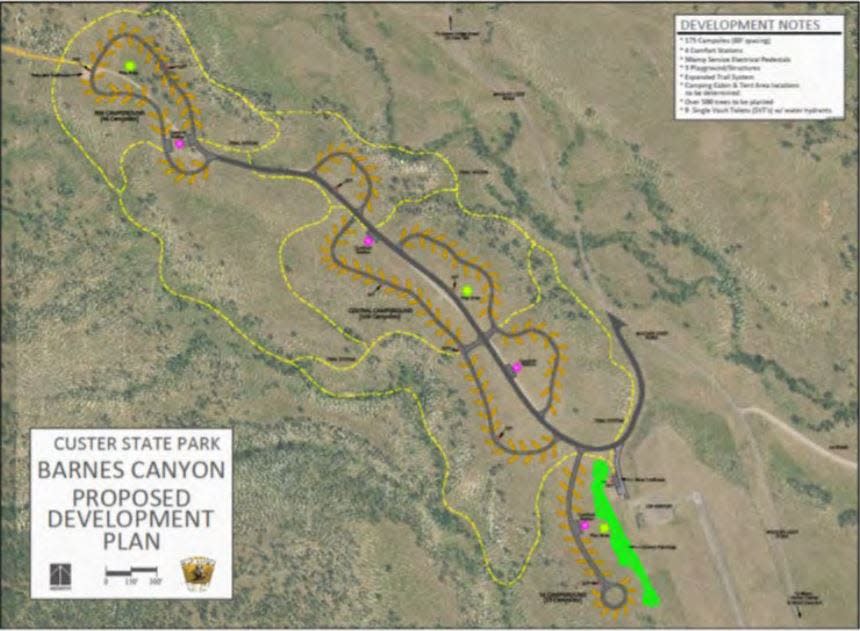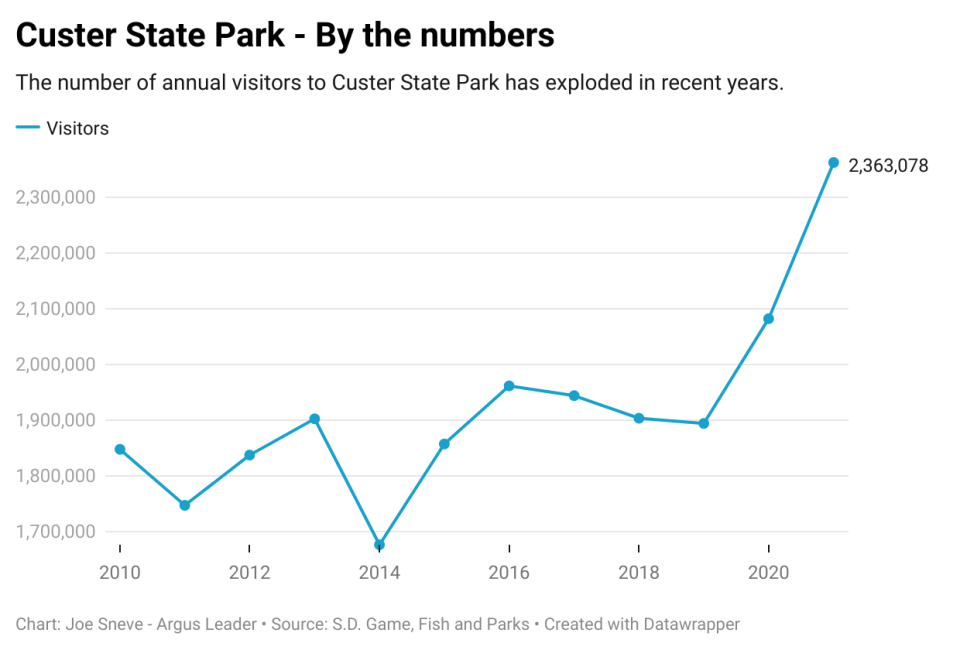Gov. Kristi Noem's $10M campground plan raises traffic, wildlife concerns in Custer State Park
- Oops!Something went wrong.Please try again later.
Tourists flocking to the Black Hills at record levels since the start of the pandemic has Gov. Kristi Noem pushing to add nearly $10 million worth of campsites at Custer State Park.
But potential disturbances to wildlife populations, vehicle traffic and the private sector that could come with a 50% increase in the 71,000-acre park's camping inventory has former park officials, lawmakers and industry groups questioning the project.
The governor's office and South Dakota Game, Fish and Parks late last year unveiled plans to develop a 75-acre site along Wildlife Loop Road known as Barnes Canyon in the west central portion of Custer State Park for camping.
More: Gov. Kristi Noem lauds South Dakota's economy, but big legislative fights are coming
The 175 proposed campsites would have electricity and be accompanied by newly constructed paved roads and four shower and bathroom facilities referred to as comfort stations. The entire project is anticipated to cost $9.9 million and would generate as much as a half million annually once operational.
"The best part about this investment is that the estimated economic impact of this expansion is so great that the project will pay for itself in a little more than a decade," Noem told lawmakers during her budget address in December.

Noem touts the camping expansion as building on the momentum experienced in the state's tourism and visitor industry over the last two years that would be a benefit for not just the region's economy, but also for South Dakota families looking to camp at Custer State Park.
Campground owners 'betrayed'
Private campground owners are rallying against the project, and former GFP and park officials are preaching caution.
Earlier this month, the South Dakota Campground Owners Association issued a scathing statement in opposition to the expansion of public-owned camping in the Black Hills. And several individual campground owners told the Argus Leader last week they feel betrayed by Noem's proposal.
Many accused the governor of hypocrisy for regularly championing free market virtues while pushing to increase state government's share of the Black Hills campground market.
"We just feel we can't compete against the financial might of state government,' said Bill Paterson, owner of the Big Pine Campground about a mile southwest of the city of Custer. "We always thought she was a governor who would be on the side of small business, but frankly, it's standing on the throats of small business."

Paterson said he'd prefer those dollars be invested standing up season workforce housing that would aid the private campgrounds in the Black Hills.
Ian Fury, a spokesman for the governor, played down the campground industry's concerns, saying the recent explosion in visitation to the Black Hills and Custer State Park specifically has created an unprecedented level of demand that’s more than enough to sustain the entire camping industry in western South Dakota.
He noted that campground capacity hasn't been expanded beyond the 341 sites and 50 cabins that are there now in 41 years, while annual visitations have grown to more than 2 million. In 2021 alone, 2.3 million people visited Custer State Park.

“South Dakota’s campground industry has been booming thanks to Governor Noem keeping South Dakota ‘Open for Business’ and promoting our state’s natural resources and beautiful landscapes,” he said.
Wildlife, traffic impacts unclear
But beyond the economics, there’s no clear outlook for how the permanent development would change other facets of Custer State Park, including traffic patterns and wildlife migration and populations. That’s because unlike national parks, which are subject to environmental and traffic impact studies, construction projects within state parks aren’t.
And the potential for unintended consequences to occur is what’s causing some apprehension about the project among former caretakers of the park like John Cooper, who served as GFP Secretary during the Janklow and Rounds administrations, and Rollie Noem, an in-law relative of the governor who was director of Custer State Park from 1985 to 2004.
Both told the Argus Leader Friday that the addition of 175 electrical campsites will undoubtedly bring more cars, trucks, campers and motorhomes into the park. That’s not to mention ATVs and adventure vehicles that are becoming increasingly common in the Black Hills.
And the increased activity in Barnes Canyon area specifically has the potential to drive wildlife away from that section of Wildlife Loop Road – and potentially out of the entire park where elk numbers already lag behind GFP targets.
More: 56th annual Governor's Buffalo Roundup sets attendance record at Custer State Park
“That is prime elk habitat area and more development and human activity is going to disturb that,” Rollie Noem said.
According to the GFP’s most recent elk management plan, published in September, Custer State Park is home to 450 elk, while the agency aspires to grow the population to between 500 and 600.
More overnight stays in the park could also create pressure on GFP in the future to offer more commercial services in the park, and should traffic congestion worsen, GFP could be forced to widen roads or install traffic lights at busy points within the park system, the former park director cautioned.
GFP did not accommodate an interview request from the Argus Leader for this article. However, Nick Harrington, communications director for the agency, said in an email that while the project is not subject to the level of scrutiny federal parks projects are, GFP would adhere to all applicable state laws and permitting regulations. And though a formal public comment period for the proposed campsites has not been opened, the Legislature and the GFP Commission are accepting constituent feedback.
If approved, construction could begin as early as 2023 with the campground opening in 2024.
This article originally appeared on Sioux Falls Argus Leader: Advocates concerned over Gov. Kristi Noem's plan for Custer State Park

